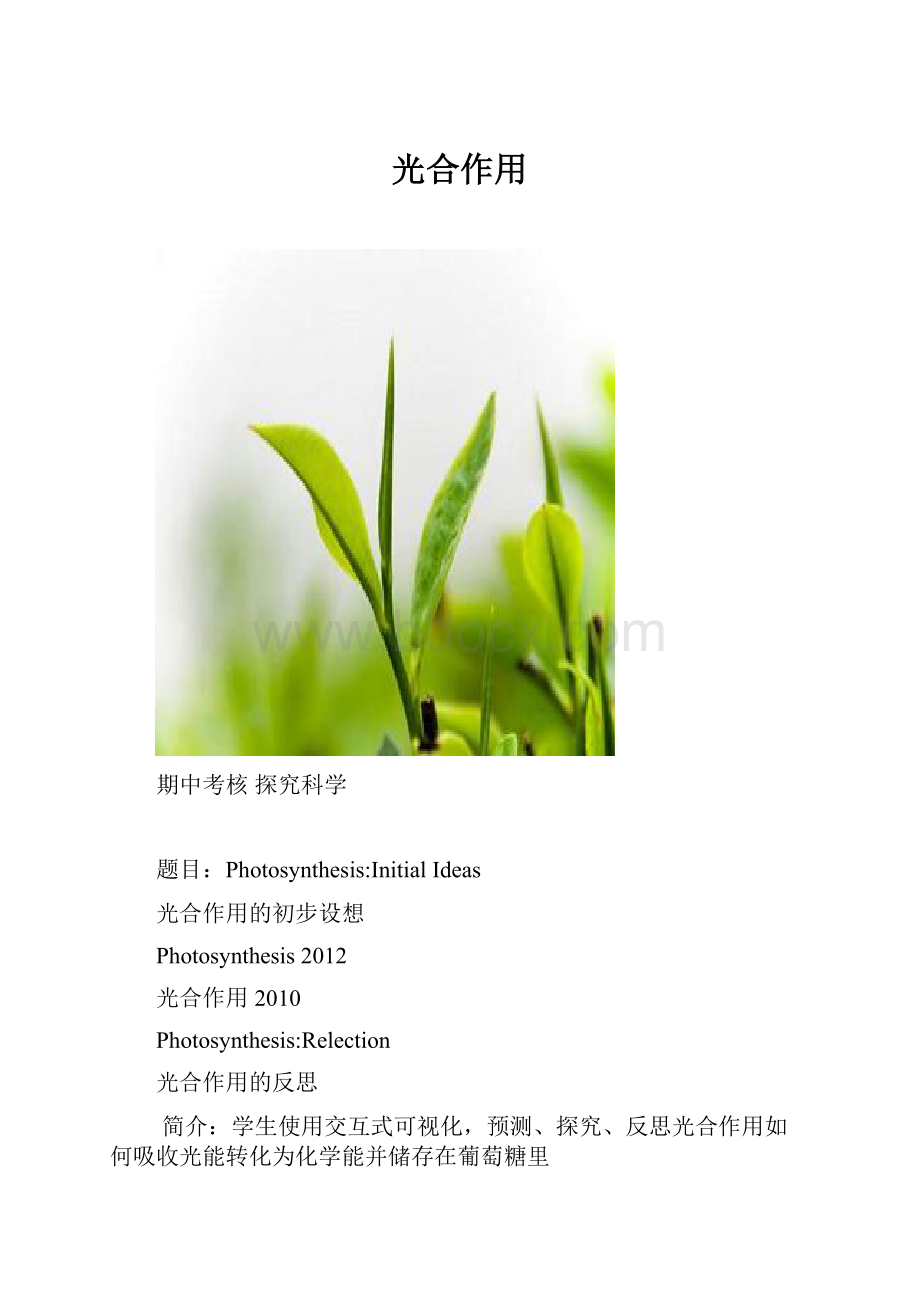光合作用.docx
《光合作用.docx》由会员分享,可在线阅读,更多相关《光合作用.docx(64页珍藏版)》请在冰豆网上搜索。

光合作用
期中考核探究科学
题目:
Photosynthesis:
InitialIdeas
光合作用的初步设想
Photosynthesis2012
光合作用2010
Photosynthesis:
Relection
光合作用的反思
简介:
学生使用交互式可视化,预测、探究、反思光合作用如何吸收光能转化为化学能并储存在葡萄糖里
科目:
Lifescience生命科学
年级:
Grade6-86-8年级
学时:
8-11hours8-11小时
语言:
English英语
学院:
物理科学与技术学院
专业:
2010级科学教育
姓名:
账号:
密码:
题目:
Photosynthesisofexploration光合作用的探究
题目1:
Photosynthesis:
InitialIdeas光合作用:
初步猜想
介绍:
LifeScience|Grades6-8|Duration:
2-3hours|English
生命科学|6-8年级2-3小时|英语
Summary:
TisprojectisdesignedtoassessstudentsideasaboutphotosynthesispriortorunningthePhotosynthesisproject.
摘要:
TIS项目的目的是光合作用光合作用的项目运行之前,以评估学生的想法。
ComputerTime:
2-3hours电脑时间:
2-3小时
题目2:
Photosynthesis2012光合作用2012
介绍:
LifeScience|Grades6-8|Duration:
4-5hours|English
生命科学|6-8年级|4-5|英语
Summary:
Usinginteractivevisualizations,studentsexplorehowlightenergyistransformedintochemicalenergyandhowthechemicalenergyisstoredinglucoseduringphotosynthesis.
摘要:
学生使用交互式可视化,探讨如何将光能转化为化学能和化学能储存的葡萄糖在Photosynth的ESIS。
TeachingTips教学技巧
Step1.16andStep2.20donotsavestudentwork.Activity2focusesonenergytransformationatthemolecularlevel.Studentsexplorehowlightenergyisusedtostartchemicalreactionsinthechloroplast,howlightenergyistransformedintochemicalenergy,andhowchemicalenergyisstoredinglucosemolecules.Step2.16isanexperimentstepusingsimulation.Ademoorclassroomdiscussionabouthowtousethesimulationcanhelpstudentsmanipulatevariablesandconductexperimentsinthisstep.Step3.6isaMySystemstep.StudentsoftenforgettochooseatypeofenergyflowingwhengeneratingMySystem.ItmaytakeawhiletoloadiconsintheMySystemstep.Ificonsaremissinginthisstep,gobacktoStep3.5.andcomebacktoStep3.6.Step3.8isanextracreditstepforadvancedstudents.
LearningGoalsandStandards学习目标和标准
GradeSixEcology(LifeSciences)5.Organismsinecosystemsexchangeenergyandnutrientsamongthemselvesandwiththeenvironment.Asabasisforunderstandingthisconcept:
a.Studentsknowenergyenteringecosystemsassunlightistransferredbyproducersintochemicalenergythroughphotosynthesisandthenfromorganismtoorganismthroughfoodwebs.b.Studentsknowmatteristransferredovertimefromoneorganismtoothersinthefoodwebandbetweenorganismsandthephysicalenvironment.e.Studentsknowthenumberandtypesoforganismsanecosystemcansupportdependsontheresourcesavailableandonabioticfactors,suchasquantitiesoflightandwater,arangeoftemperatures,andsoilcompositionResources6.Sourcesofenergyandmaterialsdifferinamounts,distribution,usefulness,andthetimerequiredfortheirformation.Asabasisforunderstandingthisconcept:
a.Studentsknowtheutilityofenergysourcesisdeterminedbyfactorsthatareinvolvedinconvertingthesesourcestousefulformsandtheconsequencesoftheconversionprocess.Grade7CellBiology1.Alllivingorganismsarecomposedofcells,fromjustonetomanytrillions,whosedetailsusuallyarevisibleonlythroughamicroscope.Asabasisforunderstandingthisconcept:
b.Studentsknowthecharacteristicsthatdistinguishplantcellsfromanimalcells,includingchloroplastsandcellwalls.d.Studentsknowthatmitochondrialiberateenergyfortheworkthatcellsdoandthatchloroplastscapturesunlightenergyforphotosynthesis.
教学技巧
步骤1.16和2.20步骤不用学生去做。
活动重点在分子水平上的能量转换。
学生探讨如何光能如何被用于化学反应中,如何把光能转化成化学能转化的化学反应,化学能如何存储在葡萄糖分子。
步骤2.16使用模拟实验步骤。
有关如何使用模拟演示或课堂讨论可以帮助学生在这一步操作变量和进行实验。
步骤3.6是一个MySystem步骤。
学生常常忘了选择一种类型的能量流动时产生MySystem。
这可能需要一段时间去加载图标在MySystem步骤。
如果在这一步图标丢失,回到步骤3.5。
回来步骤3.6。
步骤3.8是一个学生提前进行额外的分步骤。
学习目标和标准
六年级生态学(生命科学)5。
彼此之间及与环境的生态系统中交换能量和营养素的生物。
理解这个概念作为基础:
1、学生知道,太阳光由生产者转移,通过光合作用转化为化学能,然后从机体机体通过食物网的能量进入生态系统。
2、学生知道,无论是从哪一个物种转移,都是随着时间的推移在食物网中的生物和物理环境之间的转移。
学生们知道生物的生态系统可以支持的数量和类型取决于可用的能源和非生物因素,如的温度范围内,光,水,土壤成分资源的数量。
能源和材料的来源不同的量,分布,实用性,和它们的形成所需的时间。
理解这个概念作为基础:
学生知道能源的效用是由这些资源来转换成有用的形式和后果的转换过程中所涉及的因素。
七年级细胞生物学1。
3、所有的生物都是由细胞组成,作为理解这个概念的基础:
B。
学生知道的特性区分从动物细胞的植物细胞,包括叶绿体和细胞壁。
4、学生知道细胞做的工作,而叶绿体,线粒体中解放出来的能量吸收太阳光进行光合作用的能量。
Tags:
photosynthesis,energysource,energytransformation,energystorage
标签:
光合作用,能源,能量转换,能源储存
TechRequirements:
Flash,QuickTime,MySystem
ComputerTime:
4-5hour电脑时间:
4-5小时
技术要求:
闪光,QuickTime,MySystem(检查兼容性)
题目3:
Photosynthesis:
Reflection光合作用:
反思
介绍:
LifeScience|Grades6-8|Duration:
2-3hours|English
生命科学|6-8年级2-3小时|英语
Summary:
TisprojectisdesignedtoassessstudentsideasaboutphotosynthesispriortorunningthePhotosynthesisproject.
摘要:
TIS项目的目的是光合作用光合作用的项目运行之前,以评估学生的想法。
ComputerTime:
2-3hours电脑时间:
2-3小时
一、教学提示和内容标准:
TeachingTips&LearningGoalsandStandards
TeachingTips:
LearningGoalsandStandards:
二、探究步骤
1:
Photosynthesis:
InitialIdeas
2:
Photosynthesis2012
3:
Photosynthesis:
Reflection
详细如下、
步骤1.1欢迎
Welcometo WISE!
Inthisproject,youwilllearnhowplantsuseenergytogrow.
Beforebeginning,youwillanswersomequestionsaboutplantsandenergy.
Don'tworryifyoudon'tknowananswer.
Justmakeyourbestscientificguess!
Wewouldjustliketoknowwhatyoualreadyknowaboutplantsandenergy.
欢迎WISE!
在这个项目中,您将了解植物是如何利用能量来生长。
在开始之前,你将会回答一些问题关于植物和能源。
如果你不知道答案请不要担心,只要做出你最好的科学猜测,我们只想知道你已经知道的植物和能源的知识
步骤:
1.2项目背景
QUESTIONNAIRE
QUESTION
Thequestionsbelowdonothavearightorwronganswer.
TheywillbeusedtomakesureallstudentsarelearningfromWISEprojects.Pleaseanswerhonestly.
1. WhichofthefollowingBESTdescribesyou
Athome,IMOSTLYorONLYspeakEnglish.
Athome,IspeakBOTHEnglishandanotherlanguage.
Athome,IMOSTLYorONLYspeakalanguageotherthanEnglish.
2. WhichofthefollowingBESTdescribesyour parents
Athome,myparentsMOSTLYorONLYspeakEnglish.
Athome,myparentsspeakBOTHEnglishandanotherlanguage.
Athome,myparentsMOSTLYorONLYspeakalanguageotherthanEnglish.
3. IfyouandyourparentsspeakanotherlanguageotherthanEnglishathome,whatlanguagedoyouandyourparentsspeak?
IspeakChinese
MyparentsspeakChinese
调查问卷
问题
下面的问题没有正确或错误的答案,它们只是用于确保所有的学生都学习WISE项目。
请如实回答。
1。
以下哪项最能描述你
在家里,我主要或只说英语。
在家里,我讲英语和其他语言。
在家里,我主要或只说英语以外的其他语言。
2, 下列哪项最能描述你的父母
在家里,我的父母大多还是只说英语。
在家里,我的父母会讲英语和其他语言。
在家里,我的父母大多还是只说英语以外的其他语言。
3,如果你和你的父母在家里讲英语以外的另一种语言,你用什么语言和你的父母说话呢?
答:
我说中文,我父母说中文。
步骤:
1.3食物中的能量
QUESTIONNAIRE
QUESTION
1. Peoplegetenergyfromthefoodtheyeat.Wheredoestheenergystoredinfoodcomefrom?
Fertilizers
TheSoil
Vitamins
TheSun
Water
2. Explainhowenergyfromthesourceyouselectedgetsstoredinthefood.
Makeyourbestscientificguess.
Thesunexposuretheearth,andplantsabsorblightenergyforphotosynthesis,intochemicalenergyandbiomassenergy
调查问卷
问题
1。
人们从他们所吃的食物中获取能量。
食物中储存的能量从哪里获取?
肥料
土壤
维生素
“太阳”
水
2, 解释植物是怎样所选能源源头获取能量储存的。
你最好的科学猜测。
答:
太阳照射地球,和植物吸收光能量进行光合作用,为化学能源和生物质能源
步骤:
1.4叶绿体
QUESTIONNAIRE
QUESTION
1. Whatisthemainfunctionofchloroplastsinaplantcell?
Toabsorblightenergyandmanufacturefood
Toremovewastematerialsbyactivetransport
Tomanufacturechemicalenergyfromfood
Tocontroltheshapeofthecell
2. Explaintheprocessofhowchloroplastsperformthemainfunctionthatyouselectedwithdetails.
Ifyoudon'tknowananswer,justmakeyourbestscientificguess.
Chloroplastabsorbthelightandtranslatedintochemicalenergy
调查问卷
问题
1。
在植物细胞中的叶绿体的主要功能是什么?
吸收光能和制造食品
通过主动运输消化材料,
制造食物中的化学能
要控制的单元格的形状
2。
解释叶绿体执行的主要功能,你选择的细节的过程中,如果你不知道答案,只是让你的最好的科学的猜测。
答:
叶绿体吸收光能及翻译成化学能
步骤:
1.5能源的故事
能量:
光能
热能
化学能
红外辐射能
步骤:
1.6MySystem2
OPENRESPONSE
QUESTION
Anewstudentcomestoourclass.Thereisarabbitintheclassroom.Shewondershowtherabbitgetsandusesenergyfromthesun.
WriteastoryusingscientificevidencetoexplaintothenewstudenthowtherabbitGETSandUSESenergyfromthesun.
Makesureyourstoryexplains:
∙Whereenergycomesfrom
∙Howenergymoves
∙Whereenergygoes
∙Howenergychanges/transforms
一只兔子怎样从太阳中获取能量
YOURRESPONSE
Plantstoreinsidebodyhavechemicalenergyandbiomass,soilnutrientandhasvery.Oxygenispresentintheair,etcsoplantintheshorttermcanstillmaintainlifeactivities
公开回应
问题
新的学生来我们班。
在课堂上有一只兔子。
她的兔子想知道如何获取和使用来自太阳的能量。
写一个故事,用科学的证据,新的学生讲解如何兔子,GETS和使用来自太阳的能量。
确保你的故事说明:
∙能量来自哪里
∙能源移动
∙能源
∙能源更改/转换
您的回应
植物体内储存有化学能源和生物量、土壤养分和已经非常。
空气中有氧气等所以植物在短期内仍能维持生命活动
步骤:
1.7植物
OPENRESPONSE
QUESTION
我的植物为什么可以再没有阳光的情况下依然可以存活三天
Marywasgrowinghouseplantsforherrabbittoeat.Whenshelefthomeforvacation,sheforgottoopenthewindowshadesoherplantscouldgetsunlight.
Whenshecamehomeafterthreedays,shewassurprisedtofindthatherplantsturnedabityellowbutdidnotdie.
WhydoyouthinkMary'splantssurvivedwithoutgettinganysunlightforthreedays?
ShowStarterSentence
YOURRESPONSE
Mary'splantssurvivedwithoutgettinganysunlightbecausePlantstoreinsidebodyhavechemicalenergyandbiomass,soilnutrientandhasvery.Oxygenispresentintheair,etcsoplantintheshorttermcanstillmaintainlifeactivities
你的回答:
玛丽的植物幸存下来没有获得任何阳光因为植物体内储存有化学能源和生物量、土壤养分和已经非常。
空气中有氧气等所以植物在短期内仍能维持生命活动
步骤:
1.8线粒体
QUESTIONNAIRE
QUESTION
1. Whatwouldhappenifplantsdidnothavemitochondria?
Theywoulddie.
Theywouldgrowfast.
Theywouldgrowslow.
2. Explainyouranswer.Makeyourbestscientificguess.
Nomitochondriaisnorespiration,cannotundertakerespirationcanprovidebiologicalofthelifeactivitiesofthedirectenergy
调查问卷
问题
1。
如果植物没有线粒体会发生什么事?
他们会死的。
他们将快速增长。
他们将增长缓慢。
2, 解释你的答案。
你最好的科学猜测。
答:
没有线粒体是没有呼吸,不能进行呼吸可以提供生物的生命活动的直接能源
二、能量从那里来
2.1.1简介
HowCanMaryGrowtheMost